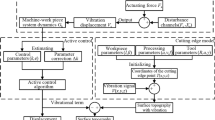Abstract
Unwanted vibrations in machining are detrimental to the equipment and the quality of the result. Notably chatter vibrations due to the regenerative effect are difficult to control and limit the achievable results. Typically, active and passive means are employed to prevent chatter from happening. This work proposes a predictive control strategy that actively uses information about the system past to predict future disturbances. Using those predicitions allows to counter the regenerative effect more effectively. The strategy is tested in simulation and improves the dynamic stability of the system greatly. It is robust with respect to quantitative errors in the disturbance predictions.














Similar content being viewed by others
References
Altintas Y (2012) Manufacturing automation. Cambridge University Press, Cambridge
Ambrósio JAC (2009) Distributed deformation: a finite element method. In: Ambrósio JAC, Eberhard P (eds) Advanced design of mechanical systems: from analysis to optimization. Springer, Berlin, pp 351–374
Antoulas A (2005) Approximation of large-scale dynamical systems. SIAM, Philadelphia
Armarego EJ, Brown RH (1969) The machining of metals. Prentice-Hall, London
Bayly PV, Halley JE, Mann BP, Davies MA (2003) Stability of interrupted cutting by temporal finite element analysis. J Manuf Sci Eng 125(2):220–225
Brecher C, Manoharan D, Ladra U, Köpken HG (2010) Chatter suppression with an active workpiece holder. Prod Eng 4(2–3):239–245
Fehr J (2011) Automated and error controlled model reduction in elastic multibody systems. Schriften aus dem Institut für Technische und Numerische Mechanik der Universität Stuttgart, Shaker Verlag, Aachen
Fischer A, Eberhard P (2011) Simulation-based stability analysis of a thin-walled cylinder during turning with improvements using an adaptronic turning chisel. Arch Mech Eng 58(4):367–391
Fischer A, Eberhard P, Ambrósio J (2013) Parametric flexible multibody model for material removal during turning. J Comput Nonlinear Dyn 9(1):011007. doi:10.1115/1.402528
Fletcher R (2000) Practical methods of optimization. Wiley, Chichester
Ganguli A, Deraemaeker A, Preumont A (2007) Regenerative chatter reduction by active damping control. J Sound Vib 300(3–5):847–862
Henninger C, Eberhard P (2005) Avoiding chatter by tuning the dynamics of the machine structure with a damped vibration absorber. In: Proceedings of the 5th Euromech Nonlinear Dynamics Conference, Eindhoven
Insperger T, Stépán G (2011) Semi-discretization for time-delay systems. Springer, New York
Kienzle O (1952) Die Bestimmung von Kräften und Leistungen and spanenden Werkzeugen und Werkzeugmaschinen (in German). Zeitschrift des Vereins Deutscher Ingenieure 94:299–305
König W, Essel K, Witte L (1981) Specific cutting force data for metal-cutting. Verein Deutscher Eisen-hüttenleute, Düsseldorf
Muske KR, Meadows ES, Rawlings JB (1994) The stability of constrained receding horizon control with State estimation. In: Proceedings of the 1994 American Control Conference, pp. 2837–2841
Rawlings JB, Mayne DQ (2009) Model predictive control: theory and design. Nob Hill, Madison
Shabana AA (2005) Dynamics of multibody systems. Cambridge University Press, Cambridge
Sims ND (2007) Vibration absorbers for chatter suppression: a new analytical tuning methodology. J Sound Vib 301(3–5):592–607
Stépán G (1998) Delay-differential equation models for machine tool chatter. In: Dynamics and chaos in manufacturing processes, pp. 165–192
Tobias SA (1965) Machine-tool vibration. Blackie and Sons, London
Tobias SA, Fishwick W (1958) Theory of regenerative machine tool chatter. Engineer 205:199–203
Wallrapp O (1994) Standardization of flexible body modeling in multibody system codes, part I: Definition of standard input data. Mech Struct Mach 22(3):283–304
Acknowledgments
The authors would like to thank the German Research Foundation (DFG) for financial support of the project within the Cluster of Excellence in Simulation Technology (EXC 310/1) at the University of Stuttgart.
Author information
Authors and Affiliations
Corresponding author
Rights and permissions
About this article
Cite this article
Fischer, A., Eberhard, P. Controlling vibrations of a cutting process using predictive control. Comput Mech 54, 21–31 (2014). https://doi.org/10.1007/s00466-014-1014-4
Received:
Accepted:
Published:
Issue Date:
DOI: https://doi.org/10.1007/s00466-014-1014-4




